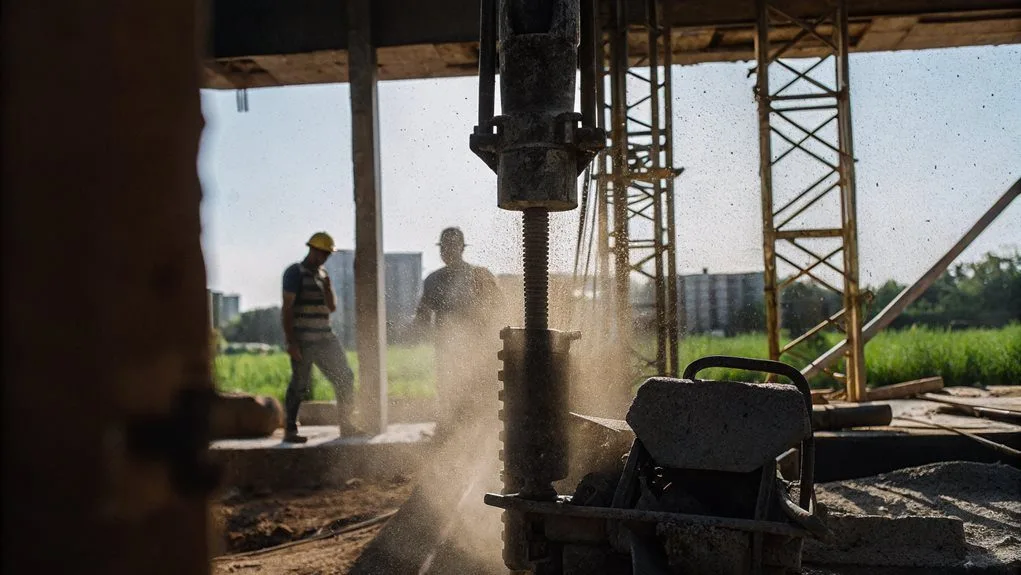Boom lifts? They’re your ticket out of the ladder-balancing circus! Forget shaky rungs whilst reaching for that high stock. With heights up to 185 ft., they let you access fixtures and shelves like a pro. Plus, you’ll save time and cash—less setup than scaffolding, more efficiency for restocking.
Just keep safety in mind: training and inspections are essential. Feeling intrigued? Stick around to learn about maintaining these beasts and their cost-effectiveness!
Key Takeaways
- Boom lifts offer versatile access to high shelves and fixtures, enhancing efficiency for warehouse maintenance tasks.
- They save time and labor costs by eliminating the need for scaffolding in high-access areas.
- Regular training and adherence to safety protocols ensure safe operation while using boom lifts.
- Owning a boom lift can be more cost-effective than continuous rentals, especially with their long lifespan.
- Regular maintenance and inspections are essential to keep boom lifts functioning efficiently and safely in warehouse operations.
Understanding Boom Lifts and Their Applications in Warehouses
Have you ever wondered how warehouses manage to keep everything organised without losing their sanity? You’d think they need magic, right? Enter boom lifts.
These beauties come in various types, from articulating boom lifts for those tricky tight spots to telescopic models that reach impressive heights—literally. Telescopic boom lifts can provide vertical heights from 40 ft. to 185 ft., making stock picking just got a whole lot easier! With their stability and mobility, boom lifts allow for safer access, making tasks more efficient.
And let’s not forget about maintenance; you won’t find yourself balancing on shaky ladders anymore, thank goodness.
Safety? Boom lifts provide stable platforms, so you can actually focus on work instead of avoiding a trip to casualty.
With a bit of training, you’ll be zipping around efficiently like a pro.
Who knew warehouse tasks could be this brilliant?
Advantages of Using Boom Lifts for Warehouse Maintenance
Using boom lifts for warehouse maintenance isn’t just a good idea; it’s practically a game changer.
Seriously, have you ever tried setting up scaffolding? It takes ages and just adds more chaos to your day.
Boom lifts zip you up to those pesky high places faster than you can say “I wish I’d done this sooner.” They save time and cut down on labour costs—who doesn’t love that? Convenient setup means less downtime and more efficient operations. Moreover, their improved access to difficult areas makes reaching high shelves or fixtures a breeze.
Plus, they handle heavy materials like a boss. Imagine breezing through restocking or repairs without breaking a sweat.
And let’s be real: nobody wants to deal with expensive scaffold hire costs! With these lifts, you’re not just working harder; you’re working smarter.
If only we could get them for the coffee runs, right?
Safety Protocols and Considerations When Using Boom Lifts
Regarding using boom lifts, safety should be at the forefront of your mind—because let’s be honest, a trip to the hospital isn’t exactly what you’d in mind for your workday.
When using boom lifts, prioritize safety—no one wants a hospital visit to interrupt their workday!
Make sure you’ve got the essential training and certification—that’s a must! Operator training meets OSHA standards and ensures you’re well-equipped to handle potential hazards. Regular maintenance ensures equipment remains in top condition.
Remember those pesky overhead power lines? They won’t move for you, so keep an eye out!
Before firing up that lift, check the ground and inspect the boom.
And hey, never overload it; it’s not a contest!
Clear communication with your team is vital, too—no one wants a surprise from a mate on the ground.
Plus, have emergency procedures in place.
Because if things go pear-shaped, you’ll want a plan, right?
Maintenance Requirements for Boom Lifts to Ensure Efficiency
When it comes to keeping boom lifts running like a well-oiled machine, regular maintenance isn’t just a good idea—it’s essential.
You wouldn’t drive a car without checking the oil, right? So, why treat your boom lift any differently?
Aim for annual inspections, but don’t slack off—check it every three months or after 150 hours of operation. Frequent inspections are crucial for catching potential problems early and ensuring consistent performance. Regular checks of hydraulic seals can prevent issues like drift and sticking controls which could compromise operation.
Daily walkarounds are your best friend for spotting issues before they wreck your day.
And let’s not forget the fluid levels and brakes; ignoring these is like skipping the safety drill.
Keep those records tight; nobody wants a surprise visit from the Department of Employment and Labour!
Evaluating the Cost-Effectiveness of Boom Lifts in Warehouse Operations
Why bother evaluating the cost-effectiveness of boom lifts? Well, you don’t want to toss your hard-earned cash into a black hole, do you? Sure, buying a boom lift can set you back anywhere from R400,000 to R1,600,000. But what about those rental prices? Daily rates can be as low as R4,000 or sky-high at R24,000!
Evaluating boom lift costs is crucial—owning saves you from daily rental fees that can spiral out of control!
If you’re planning on using one frequently, you’ll save money by owning instead of hiring—eventually.
Less setup time means more productivity (you like that, right?).
And let’s not forget—boom lifts typically last 10 to 20 years, rather like those shoes you should’ve thrown away ages ago.
Conclusion
So, are boom lifts the right tool for your warehouse maintenance? Well, unless you fancy playing a game of “let’s see how high we can reach with a ladder,” they’re probably your best bet. Sure, they can seem pricey, but think about the time and backaches you’ll save. Just remember, with great height comes great responsibility. Don’t let your new toy make you the star of a workplace safety video gone wrong. So, what’ll it be?






